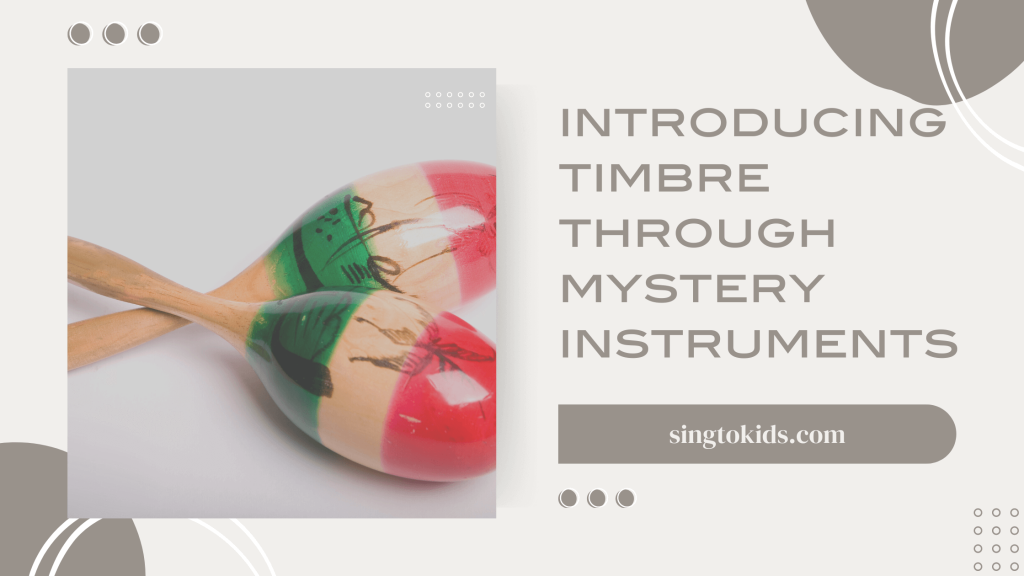One of the most challenging parts of remote teaching was incorporating instruments into my instruction. My elementary music room is a hands-on learning environment with instruments being played most days. During remote instruction, not only could we not play instruments, but it was challenging to show instruments too!
The Beginning of the Mystery Instruments
My workaround for this was to create “Mystery Instrument” videos for my students using common classroom instruments. Each week, I recorded a 2-3 minute video with me playing an instrument off camera. I offered three clues about the instrument having to do with the materials it was made of and/or how it was played. I paused the video before the reveal and gave students the opportunity to guess what instrument they were hearing. Upon the reveal of the instrument, more information was shared like instrument family, country of origin, etc. It was one simple way to teach timbre and keep instruments as part of our lesson even when we weren’t in the music room.
Since returning to in-person instruction, the Mystery Instrument videos have remained part of our weekly K-2 lessons. I’ve found them to be a wonderful way to get students to listen to different timbres and explore classifications (see Melissa Angstadt’s post about instrument classification). If we are going to use a specific instrument in a classroom activity, then I introduce the instrument the week prior as a Mystery Instrument.
Mystery Instrument Videos
Interested in seeing the videos for yourself? Here are some of the instruments I’ve made videos for:
- Mystery Instrument 1: Woodblock
- Mystery Instrument 2: Triangle
- Mystery Instrument 3: Resonator Bells
- Mystery Instrument 4: Sand Blocks
- Mystery Instrument 5: Tambourine
- Mystery Instrument 6: Spring Drum
- Mystery Instrument 7: Vibraslap
- Mystery Instrument 8: Flexatone
- Mystery Instrument 9: Claves
- Mystery Instrument 10: Ratchett
- Mystery Instrument 11: Maracas
- Mystery Instrument 12: Two Tone Wood Agogo
- Mystery Instrument 13: Slapstick
- Mystery Instrument 14: Jingle Bells
- Mystery Instrument 15: Ocean Drum
- Mystery Instrument 16: Stirring Xylophone
- Mystery Instrument 17: Finger Cymbals
- Mystery Instrument 18: Castanets
- Mystery Instrument 19: Cabasa
- Mystery Instrument 20: Xylophones
- Mystery Instrument 21: Metallophones
- Mystery Instrument 22: Glockenspiels
- Mystery Instrument 23: Bass Bars
- Mystery Instrument 24: Tin Whistle
- Mystery Instrument 25: Ocarina
- Mystery Instrument 26: Guiro
- Mystery Instrument 27: Temple Blocks
- Mystery Instrument 28: Rainstick
- Mystery Instrument 29: Frog Rasp
- Mystery Instrument 30: Boomwhackers
- Mystery Instrument 31: Chime Tree
- Mystery Instrument 32: Slit Drum
- Mystery Instrument 33: Mbira
- Mystery Instrument 34: Drums
All of these videos can be found on my YouTube Channel, SingtoKids. You can also access the Playlist here. I have a list of other instruments I would love to add as we explore a variety of other instruments as an introduction to our band and string programs! How do you introduce timbre in your classroom? Leave me a comment below!




Great read! Loved the idea of Mystery Instrument videos for teaching timbre, especially during remote lessons. Bringing it back to in-person classes is brilliant. The list of instruments covered is awesome. Thanks for sharing this creative solution! Cheers!